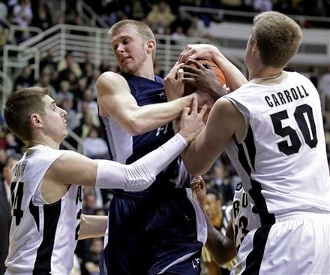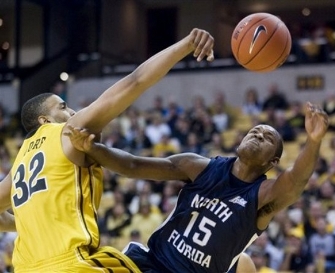Frank Erwin Center | Austin, TX | Tip: 7 P.M. CT | TV: FSN (in Texas); ESPN Full Court They say it’s beginning to look a lot like Christmas. Or at least, that’s what the terrible music screams from speakers in every single retail store across America. But while that means snow and ice for folks in the north and long hours for our friends at the USPS, it also means a dearth of quality basketball. Tonight, the Longhorns take part in yet another of those mediocre matchups that litter the mid-December schedule. With North Carolina and Michigan State looming for the Longhorns in the next seven days, Texas gets one last tune-up against North Florida, a school that is still transitioning to Division I basketball under the guidance of head coach Matt Driscoll, a former Baylor assistant coach. The Ospreys have never defeated a ranked opponent in their brief history as a D-I school, but made a big step earlier this year by dominating Wyoming in an early-season tournament in Cheyenne back on November 18th. The 18-point win might not seem like much to fans of big conference basketball, but for a school that went 12-74 during their first three seasons, it was a huge accomplishment.
Matt Sauey and the Ospreys have had a tough start By the numbers North Florida is a very small team, and it shows in the stats. There are no Ospreys that are taller than 6’7″, and as a result, they give up a ton of second- and third-chance points to their opponents. North Florida grabs less than 40% of their defensive rebounding opportunities, which puts them among the 30 worst teams in the country in that metric. The numbers aren’t much better anywhere else. The team posts a negative 0.095 point differential per possession, and they cough up the ball more than once every four trips down the floor. Their terrible turnover rate is actually 9th-worst in all of Division I basketball. The Ospreys also fail to attack the lane with any regularity, which means they mostly take jumpers and hardly ever get to the line. North Florida actually shoots the ball, with a team effective field goal percentage that’s north of 49 percent. Unfortunately, they have an average turnover differential of negative six, so they often don’t hang on to the ball long enough to actually shoot it. When the team is hitting their jumpers, they can stay in ballgames with opponents that are far more talented. More often than not, however, their 19 turnovers a game put them in an early hole they have no chance of digging out of. Meet the Ospreys Coach Driscoll has the luxury of four returning starters at his disposal, but all of that returning experience is still rather young. There are six sophomores on the North Florida roster, and only one senior, Brad Haugabrook, can be found in the starting five. Haugabrook is a pure point guard and leads the team with 30 assists so far, but that doesn’t mean he isn’t a scoring threat. The senior guard is incredibly quick with the ball and knows how to get to the rim, but he can stop on a dime and drop the pull-up jumper with ease. He’s averaging nine points per game so far, good for third on the team. The leading scorer for the Ospreys is Parker Smith, a transfer from Tennessee State who has yet to start a game. He brings a much-needed long-range threat to the North Florida roster, and his 20 threes on the season have helped to buoy his scoring average to a 10.2 mark. Big man Andres Diaz is also scoring 10.2 points per game, but is serving an even more important role as the team’s leading rebounder. For a very small North Florida team with almost no depth in the frontcourt, Diaz is the key man inside. The Ospreys will have to improve their defensive rebounding if they want to have any shot in this game, so Diaz needs to be aggressive on the glass. The major knock on Diaz is his complete inability to sink free throws, something that can really hamper a big man. Last year, Andres made just 37.6% of his shots from the line, but has made big strides so far this season. Although he’s still only making 57.1% of his free throws, the drastic improvement is worth a few extra points for the Ospreys each night. Junior Matt Sauey is the only other true forward who sees significant playing time for North Florida, and he’s turning his 24 minutes a night into eight points and 3.4 boards. He’s long and athletic, and is without a doubt the best post defender the Ospreys have. Unfortunately, at just 6’7″, he’s often fighting an uphill battle when matching up against opposing big men.
Defenses are keying on Jerron Granberry this year Last year’s leading scorer was Jerron Granberry, and the fact that he averaged just nine points per game makes it crystal clear just how anemic the North Florida offense was in 2009-10. This year, he’s averaging 10 points a night and is leading the team with more than 29 minutes a game. Granberry is a stocky 6’4″ swingman who is incredibly quick in the open floor and off the dribble. Besides Smith, he’s the only other three-point threat that plays significant minutes for Coach Driscoll. At shooting guard, transfer Jimmy Williams has started every game since arriving from South Carolina State. Like Granberry, Williams checks in at 6’4″, and the two guards are combining for nearly nine rebounds a night. For such a poor rebounding team, having that contribution from the backcourt is huge. Beyond the core rotation of six, the Ospreys also get a few minutes each from Charles McRoy, David Juene, and Brian Holmes. McRoy is a freshman swingman who has looked good from behind the arc in his limited minutes. He’s 5-for-11 from long range so far this season, but is still playing less than 15 minutes a night. Juene is mostly used as a backup for Diaz and Sauey, so if either of them end up in foul trouble tonight, the sophomore forward will have to step up. Holmes is another freshman, and Coach Driscoll is hoping that the scoring-minded point guard will be able to step into Haugabrook’s role next season. This year, he’s really struggled with ball control and has turned it over 21 times despite playing just 14 minutes a game. He likely won’t make a big impact tonight, but the game should be a valuable learning experience for the shaky freshman. Keys to the game Like the Texas State game on Saturday, this one should never be in doubt and is simply another opportunity for the Longhorns to improve upon things that they have been struggling with. Rather than actual keys to the game, here are three things we’ll be watching tonight: 1) How does Texas attack the zone? – Coach Driscoll is in his second season after serving as an assistant at Baylor, so he knows firsthand how Texas struggles with the zone defense. Although the Ospreys played mostly man last season, they did show both a 2-3 and a 1-3-1 against Purdue on Saturday, and it’s likely they will use those looks again tonight. On Saturday, the Longhorns were on fire from behind the arc, and Gary Johnson was knocking down the midrange jumper. That rendered the Texas State zone all but useless. Tonight, we’ll be watching to see if Texas can continue that success when the Ospreys inevitably bunker down in a zone. 2) Which J’Covan will show up? – J’Covan Brown has been an enigmatic player so far this season, mixing brilliant performances with frustrating, immature displays. It certainly looks like he’s made strides since last year, and it’s a game like this in which he should really shine. We’ll be keeping an eye on J’Covan to see how he handles adversity, if there is any to be found tonight. 3) Can Texas finally force turnovers? – The Longhorns are in the bottom half of the national rankings when it comes to forcing turnovers. Opponents cough it up just 20% of the time, which is only 214th-best out of 345 Division I teams. We’ve mentioned just how terrible the Ospreys are at protecting the ball, so it would be nice to see the Longhorns turn up the pressure and rattle this young, skittish North Florida team. |
2 Responses to “Texas tunes up against North Florida”











on 14 Dec 2010 at 7:10 pm # Tweets that mention Longhorn Road Trip » Texas tunes up against North Florida -- Topsy.com
[…] This post was mentioned on Twitter by Texas Longhorns Buzz and Ryan Becerra, Ryan Clark. Ryan Clark said: No frills on this tweet. Preview tonight's match-up with North Florida here: http://ow.ly/3phHm […]
on 14 Dec 2010 at 7:50 pm # Texas Basketball Versus North Florida Open Thread
[…] As far as previews go, the major news here is that there actually is a school called North Florida. And they have a basketball team. A short one, with no starters over 6-7. If you’re the greedy type and actually expect a real preview for this game, head on over to Longhorn Road Trip and check out Ryan’s preview. […]